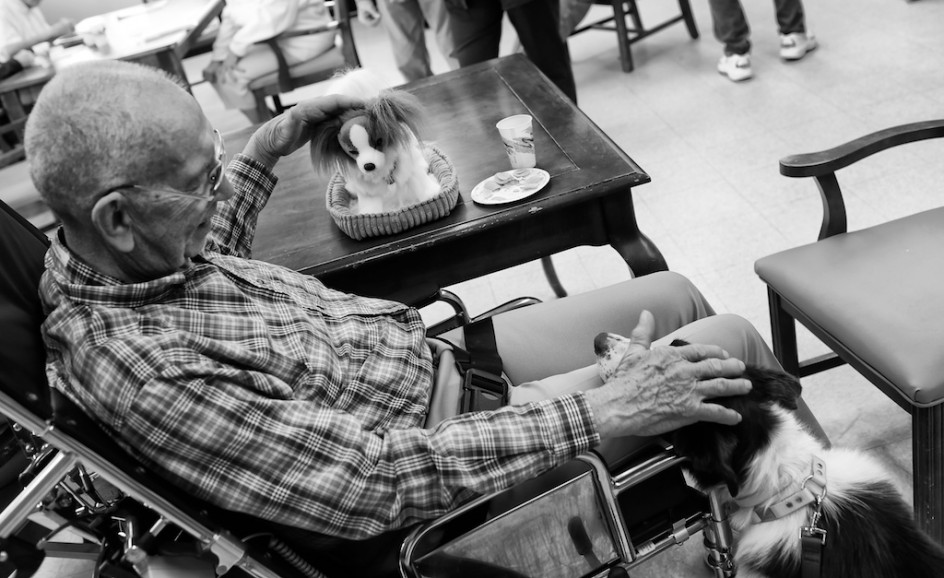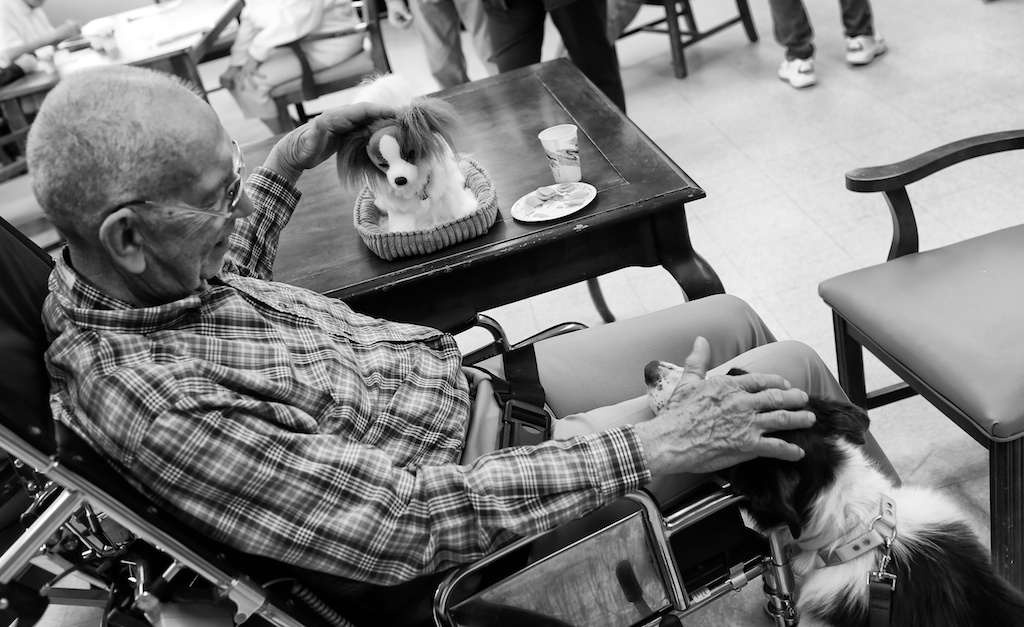
George loves dogs, he has one of his own in the dementia unit, for awhile this week, he had two.
Food always seems to be an issue with any kind of dog or training work, it comes up every time I do therapy work, it halted Lenore’s hospice therapy work, was challenging for Izzy and will be major challenge for Red also. Dog focus on food, they love it, it is their survival in so many respects. Much of dog’s affection for people comes from their learning that people offer them food, they are life and death. There are all kinds of therapy work, some involves walking down hallways, sitting still for pats and touching, others involve going into hospice and dementia units, into private rooms in nursing homes, or group therapy settings in meeting rooms.
Wherever we go, there is food tempting Red. The staff and nurses all offer treats, bring treats out, the patients have food in trays, on tables, on their hands and clothes, in cups and plates. There are cafeterias where food is sometimes spilled, and aromas of food everywhere. And almost everyone wants to give dogs treats, there is such an interesting boundary between what dogs need and people need to give dogs. Food is a human’s way of showing love, and many people with therapy dogs tell me they don’t mind at all when people give their dogs food or treats.
I do mind, I can’t think of any quicker way to ruin the kind of therapy work I want to do than bringing food into the equation. Just as Red focuses on the sheep intensely – and without food, which would be a crippling distraction – so must he focus on the patient, not on the notion of treats and food rewards. Food is a powerful distraction for dogs with intense instincts. When I bring Red into a room or near a wheelchair, he must understand that the work is focus and attention, the patients need to see the dog as looking at them, connecting with them, caring for them.
I control food closely at home. Dogs are never fed from the table, and never fed anything but their own food. Apart from the bowl there is no expectation of food (except for Lenore, of course, who looks for food anywhere.)
Several times, people have offered treats to Red as he is approaching a patient. Usually they don’t ask, but when they do I ask them not to. The last thing I want is for him to look at food when he is walking straight on up to a patient, I want him to make eye contact, keep it for awhile, be still while he is petted or talked to or even just looked at. This work is not about food any more than sheep herding is, it is about people. The same problems occurs at readings, even at bookstore visits, where I try and explain to people that readings are not about food, Red is very well fed and he is not going outside of the farm to eat.
Lenore’s hospice work ended because several staff members in hospice wards offered her treats, and that is what she began to look for, even on patient’s plates, which are often on low trays or the side of beds. She ate a patient’s dinner, and I stopped working with her in hospice, nursing homes, hospice units and dementia wards, as she was no longer trustworthy there, as genial and loving as she is. These are the absolutely last places you ever want to disappoint or disturb anyone.
I am making this clear as Red and I begin our therapy work, I want him to be as focused on the patients as he is on the sheep, and I see that many people don’t grasp this, they just want to be nice to the dog and do not see the risk or harm. The great working dogs are kept in crates and barns when they are working in order to give them the kind of focus Red has. I don’t want him to live like that but training therapy dogs for me is not as simple as walking them up and down hallways. I suppose it looks easy, but it is not.
When we go into a room and Red put’s his head in the lap of a patient who is eating dinner, I don’t want him to even think about licking the hands or plate or breaking off contact to pay attention to the food. This is one of the great challenges for me in the early stages of therapy work, making it clear to Red what the work is, keeping people from approaching him with hands or pockets full of treats and reinforcing the real purpose of the work – the patients.

